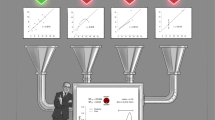Abstract
Scientists use a variety of modes of representation in their work, but philosophers have studied mainly sentences expressing propositions. I ask whether diagrams are mere conveniences in expressing propositions or whether they are a distinct, ineliminable mode of representation in scientific texts. The case of path analysis, a statistical method for quantitatively assessing the relative degree of causal determination of variation as expressed in a causal path diagram, is discussed. Path analysis presents a worst case for arguments against eliminability since path diagrams are usually presumed to be mathematically or logically “equivalent” in an important sense to sets of linear path equations. I argue that path diagrams are strongly generative, i.e., that they add analytical power to path analysis beyond what is supplied by linear equations, and therefore that they are ineliminable in a strong scientific sense.
Similar content being viewed by others
References
Cartwright, N.: 1983,How the Laws of Physics Lie, Oxford University Press, New York.
Cartwright, N.: 1989,Nature's Capacities and Their Measurement, Oxford University Press, New York.
Duhem, P.: 1954,The Aim and Structure of Physical Theory, Princeton University Press, Princeton.
Fisher, R. A.: 1918, ‘The Correlation Between Relatives on the Supposition of Mendelian Inheritance’,Transactions of the Royal Society of Edinburgh 52, 399–433.
Goodman, N.: 1976,Languages of Art, Hackett Publishing Co., Indianapolis.
Goodman, N., and C. Elgin: 1988,Reconceptions in Philosophy and Other Arts and Sciences, Hackett Publishing Co., Indianapolis.
Griesemer, J., and W. Wimsatt: 1989, ‘Picturing Weismannism: A Case Study of Conceptual Evolution’, in M. Ruse (ed.),What the Philosophy of Biology Is, Essays for David Hull, Kluwer Academic Publishers, Dordrecht, pp. 75–137.
Hacking, I.: 1983,Representing and Intervening, Cambridge University Press, Cambridge.
Hull, D.: 1976, ‘Informal Aspects of Theory Reduction’, in R. Cohen and A. Michalos (eds.),PSA 1974, D. Reidel, Dordrecht, pp. 653–670.
Irzik, G.: 1986, ‘Causal Modeling and the Statistical Analysis of Causation’, in A. Fine and P. Machamer (eds.),PSA 1986, Vol. 1, Philosophy of Science Association, East Lansing, pp. 12–23.
Irzik, G., and E. Meyer: 1987, ‘Causal Modeling: New Directions for Statistical Explanations’,Philosophy of Science 54, 495–514.
Johnson-Laird, P.: 1983,Mental Models, Harvard University Press, Cambridge.
Larkin, J., and H. Simon: 1987, ‘Why a Diagram Is (Sometimes) Worth Ten Thousand Words’,Cognitive Science 11, 65–100.
Latour, B.: 1987,Science in Action, Harvard University Press, Cambridge.
Li, C.: 1975,Path Analysis—A Primer, Boxwood Press, Pacific Grove.
Nersessian, N.: 1987, ‘A Cognitive-Historical Approach to Meaning in Scientific Theories’, in N. Nersessian (ed.),The Process of Science, Martinus Nijhoff Publishers, Dordrecht, pp. 161–177.
Nersessian, N.: 1988, ‘Reasoning from Imagery and Analogy in Scientific Concept Formation’, in A. Fine and J. Leplin (eds.),PSA 1988, Vol. 1, Philosophy of Science Association, East Lansing, pp. 41–47.
Nickles, T.: 1989, ‘Truth or Consequences? Generative Versus Consequential Justification in Science’, in A. Fine and J. Leplin (eds.),PSA 1988, Vol. 2, Philosophy of Science Association, East Lansing, pp. 393–405.
Niles, H. E.: 1922, ‘Correlation, Causation, and Wright's Theory of “Path Coefficients”’,Genetics 7, 258–273.
Provine, W.: 1986,Sewall Wright and Evolutionary Biology, University of Chicago Press, Chicago.
Schank, J., and W. Wimsatt: 1987, ‘Generative Entrenchment and Evolution’, in A. Fine and P. Machamer (eds.),PSA 1986, Vol. 2, Philosophy of Science Association, East Lansing, pp. 33–60.
Tukey, J.: 1954, ‘Causation, Regression and Path Analysis’, in O. Kempthorne, T. Bancroft, J. Gowen and J. Lush (eds.),Statistics and Mathematics in Biology, Iowa State College Press, Ames, pp. 35–66.
Turner, M., and C. Stevens: 1959, ‘The Regression Analysis of Causal Paths’,Biometrics 15, 236–258.
Wimsatt, W.: 1976, ‘Reductive Explanation: A Functional Account’, in R. Cohen and A. Michalos (eds.),PSA 1974, D. Reidel, Dordrecht, pp. 671–710.
Wimsatt, W.: 1980, ‘Reductionistic Research Strategies and Their Biases in the Units of Selection Controversy’, in T. Nickles (ed.),Scientific Discovery: Case Studies, D. Reidel, Dordrecht, pp. 213–259.
Wimsatt, W.: 1986, ‘Developmental Constraints, Generative Entrenchment, and the Innate-Acquired Distinction’, in W. Bechtel (ed.),Integrating Scientific Disciplines, Martinus Nijhoff Publishers, Dordrecht, pp. 185–208.
Wittgenstein, L.: 1961,Tractatus Logico-Philosophicus, D. Pears and B. McGuinness (transl.), Routledge and Kegan Paul, London.
Woodward, J.: 1988, ‘Understanding Regression’, in A. Fine and J. Leplin (eds.),PSA 1988, Vol. 1, Philosophy of Science Association, East Lansing, pp. 255–269.
Wright, S.: 1918, ‘On the Nature of Size Factors’,Genetics 3, 367–374.
Wright, S.: 1920, ‘The Relative Importance of Heredity and Environment in Determining the Piebald Pattern of Guinea Pigs’,Proceedings of the National Academy of Science 6, 320–332.
Wright, S.: 1921a, ‘Correlation and Causation’,Journal of Agricultural Research 20, 557–585.
Wright, S.: 1921b, ‘Systems of Mating’,Genetics 6, 111–178.
Wright, S.: 1923a, ‘Mendelian Analysis of the Pure Breeds of Livestock I. The Measurement of Inbreeding and Relationship’,Journal of Heredity 14, 339–348.
Wright, S.: 1923b, ‘The Theory of Path Coefficients — A Reply to Niles' Criticism’,Genetics 8, 239–255.
Wright, S.: 1934, ‘The Method of Path Coefficients’,Annals of Mathematical Statistics 5, 161–215.
Wright, S.: 1954, ‘The Interpretation of Multivariate Systems’, in O. Kempthorne, T. Bancroft, J. Gowen and J. Lush (eds.),Statistics and Mathematics in Biology, Iowa State College Press, Ames, pp. 11–33.
Wright, S.: 1960, ‘Path Coefficients and Path Regressions: Alternative or Complementary Concepts?’,Biometrics 16, 189–202.
Wright, S.: 1968,Evolution and the Genetics of Populations, Vol. 1, Genetic and Biometric Foundations, University of Chicago Press, Chicago.
Wright, S.: 1984, ‘Diverse Uses of Path Analysis’, in A. Chakravarti (ed.),Human Population Genetics, Van Nostrand Reinhold Co., New York, pp. 1–34.
Author information
Authors and Affiliations
Additional information
I wish to thank Michael Ruse and Peter Taylor for helpful comment on the manuscript.
Rights and permissions
About this article
Cite this article
Griesemer, J.R. Must scientific diagrams be eliminable? The case of path analysis. Biol Philos 6, 155–180 (1991). https://doi.org/10.1007/BF02426836
Issue Date:
DOI: https://doi.org/10.1007/BF02426836



